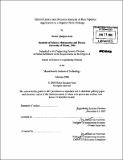| dc.contributor.advisor | Richard de Neufville. | en_US |
| dc.contributor.author | Quispez-Asin, Nestor | en_US |
| dc.contributor.other | Massachusetts Institute of Technology. Engineering Systems Division. | en_US |
| dc.date.accessioned | 2008-12-11T18:42:03Z | |
| dc.date.available | 2008-12-11T18:42:03Z | |
| dc.date.copyright | 2008 | en_US |
| dc.date.issued | 2008 | en_US |
| dc.identifier.uri | http://hdl.handle.net/1721.1/43866 | |
| dc.description | Thesis (S.M.)--Massachusetts Institute of Technology, Engineering Systems Division, 2008. | en_US |
| dc.description | MIT Barker Engineering Library copy: issued printed in pages. | en_US |
| dc.description | Also issued printed in pages. | en_US |
| dc.description | Includes bibliographical references (leaves 115-116). | en_US |
| dc.description.abstract | In many real world systems, two types of uncertainties exist: those that evolve in small, continuous increments and those that may create large, discrete changes in the system. The field of engineering real options posits that flexible system designs can improve system performance in the face of such uncertainties. However, up to now, most analyses of engineering real options deal with one type of uncertainty at a time. One common analysis method for the incremental uncertainty is done by using binomial lattices, while the discrete changes are typically analyzed using traditional decision analysis. This thesis develops a new hybrid method which combines the lattice and decision analyses for the evaluation of real options. This method makes it possible to account for and display both types of uncertainties at the same time while drawing on the strengths of the two traditional methods. The main advantage is that decision makers are able to compare distributions resulting from strategies rather than only comparing single value evaluations such as expected net present value. The description of the distributions is made via Value at Risk and Gain (VARG) graphs. Also, risk preferences of decision makers are considered directly, rather than by the use of artificial utility functions or by evading the issue entirely. The main disadvantage of the method is that its complexity grows exponentially if many time periods, decision, and chance events are introduced. Therefore, the procedure is outlined for two stages of analysis step by step, and it has been programmed in Excel. To illustrate the method, an application to a supply chain strategy is developed for a computer wholesale company. The situation facing the company is whether to set up a local distribution mode (LDM) in a region experiencing increasing demand. | en_US |
| dc.description.abstract | (cont.) The competition may also decide to establish local distribution in the region. In this light, the incremental uncertainty is the growth of demand while the discrete uncertainty is the competition's decision to enter the market locally. | en_US |
| dc.description.statementofresponsibility | by Nestor Quispez-Asin. | en_US |
| dc.format.extent | 116 leaves | en_US |
| dc.language.iso | eng | en_US |
| dc.publisher | Massachusetts Institute of Technology | en_US |
| dc.rights | M.I.T. theses are protected by
copyright. They may be viewed from this source for any purpose, but
reproduction or distribution in any format is prohibited without written
permission. See provided URL for inquiries about permission. | en_US |
| dc.rights.uri | http://dspace.mit.edu/handle/1721.1/7582 | en_US |
| dc.subject | Engineering Systems Division. | en_US |
| dc.title | Hybrid lattice and decision analysis of real options : application to a supply chain strategy | en_US |
| dc.type | Thesis | en_US |
| dc.description.degree | S.M. | en_US |
| dc.contributor.department | Massachusetts Institute of Technology. Engineering Systems Division | |
| dc.identifier.oclc | 263168946 | en_US |
